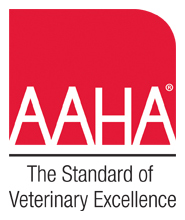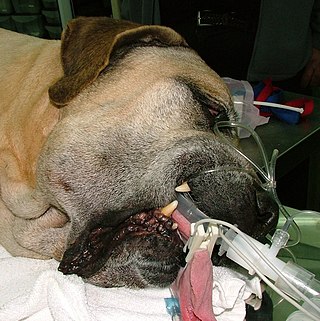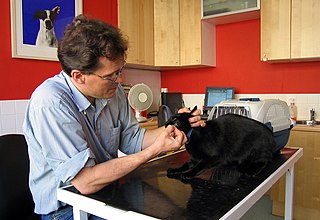Related Research Articles

A profession is a field of work that has been successfully professionalized. It can be defined as a disciplined group of individuals, professionals, who adhere to ethical standards and who hold themselves out as, and are accepted by the public as possessing special knowledge and skills in a widely recognised body of learning derived from research, education and training at a high level, and who are prepared to apply this knowledge and exercise these skills in the interest of others.

Veterinary medicine is the branch of medicine that deals with the prevention, management, diagnosis, and treatment of disease, disorder, and injury in non-human animals. The scope of veterinary medicine is wide, covering all animal species, both domesticated and wild, with a wide range of conditions that can affect different species.

A veterinarian (vet) is a medical professional who practices veterinary medicine. They manage a wide range of health conditions and injuries in non-human animals. Along with this, veterinarians also play a role in animal reproduction, health management, conservation, husbandry and breeding and preventive medicine like nutrition, vaccination and parasitic control as well as biosecurity and zoonotic disease surveillance and prevention.

Professional ethics encompass the personal and corporate standards of behavior expected of professionals.

The American Veterinary Medical Association (AVMA), founded in 1863, is a not-for-profit association representing more than 105,000 veterinarians in the US.

Onychectomy, popularly known as declawing, is an operation to remove an animal's claws surgically by means of the amputation of all or part of the distal phalanges, or end bones, of the animal's toes. Because the claw develops from germinal tissue within the third phalanx, amputation of the bone is necessary to fully remove the claw. The terms onychectomy and declawing imply mere claw removal, but a more appropriate description would be phalangectomy, excision of toe bone.
A veterinary specialist is a veterinarian who specializes in a clinical field of veterinary medicine.
The Veterinarian's Oath was adopted by the American Veterinary Medical Association's House of Delegates July 1969, and amended by the AVMA Executive Board, November 1999 and December 2010.
Being admitted to the profession of veterinary medicine, I solemnly swear to use my scientific knowledge and skills for the benefit of society through the protection of animal health and welfare, the prevention and relief of animal suffering, the conservation of animal resources, the promotion of public health, and the advancement of medical knowledge.
I will practice my profession conscientiously, with dignity, and in keeping with the principles of veterinary medical ethics. I accept as a lifelong obligation the continual improvement of my professional knowledge and competence.

Institutional Animal Care and Use Committees (IACUCs) are centrally important in applying laws about animal research in the United States. Similar systems operate in other countries, but generally under different titles; for example, in Canada a typical title would be the University Animal Care Committee (UACC), while in the United Kingdom it would be the Animal Welfare and Ethical Review Body (AWERB).

Veterinary education is the tertiary education of veterinarians. To become a veterinarian, one must first complete a degree in veterinary medicine Doctor of Veterinary Medicine.
A veterinary pharmacist is a specially trained pharmacist who dispenses veterinary drugs and supplies or products and advice to owners of companion animals and livestock. In addition, they advise the regulatory bodies and are involved in the formulation of veterinary drugs. Veterinary pharmacy is a field of pharmacy practice, in which veterinary pharmacists may compound medications, fill prescriptions, and manage drug therapies for animals. Veterinary pharmacists are licensed pharmacists who specialize in the distribution of medications for animals.
The Student American Veterinary Medical Association (SAVMA) is a national association of student chapters of the American Veterinary Medical Association (AVMA) at schools and colleges of veterinary medicine in the United States, Canada and the Caribbean. SAVMA acts as a single national voice for veterinary students in accordance with the policies and goals of the AVMA, coordinates AVMA student chapter activities, facilitates the exchange of information, and represents the interests of student veterinarians within AVMA, the veterinary profession and in the political and legislative arenas nationally.

The American Animal Hospital Association (AAHA) is a non-profit organization for companion animal veterinary hospitals. Established in 1933, the association is the only accrediting body for small animal hospitals in the U.S. and Canada. The association develops standards for veterinary business practices, publications, and educational programs. Any veterinary hospital can join AAHA as a member, but must then pass an evaluation in order to receive AAHA accreditation.

Animal dysthanasia refers to the practice of prolonging the life of animals that are seriously or even terminally ill and that are potentially experiencing suffering. Animal dysthanasia is a recent concept, emerging from changes in the social perception of animals and from advances in veterinary care.
A Veterinary Feed Directive (VFD) is, under the law of the United States, a written authorization allowing animal keepers to use animal feed containing specified antibiotics in accordance with Food and Drug Administration (FDA) approved directions for use.

A paraveterinary worker is a professional of veterinary medicine who performs procedures autonomously or semi-autonomously, as part of a veterinary assistance system. The job role varies throughout the world, and common titles include veterinary nurse, veterinary technician, and veterinary assistant, and variants with the prefix of "animal health".

Veterinary medicine in the United Kingdom is the performance of veterinary medicine by licensed professionals. It is strictly regulated by the statute law, notably the Veterinary Surgeons Act 1966. Veterinary medicine is led by veterinary physicians, termed "veterinary surgeons", normally referred to as "vets".

The American College of Veterinary Surgeons (ACVS) is the specialty board that defines the standards of surgical excellence for the field of veterinary medicine, promotes advancements in veterinary surgery, and provides the latest in veterinary surgical educational programs. The ACVS is responsible for overseeing the training, examination, and certification of board-certified veterinary surgeons.

Veterinary medicine in the United States is the performance of veterinary medicine in the United States, normally performed by licensed medical professionals, and subject to provisions of statute law which vary by state. Veterinary medicine is normally led by veterinary physicians, termed veterinarians or vets, but also by paraveterinary workers, such as veterinary technicians, and veterinary assistants. This can be augmented by other paraprofessionals with specific specialties, such as animal physiotherapy or dentistry, and species-relevant roles such as farriers.

Alexandre François Augustin Liautard was a French veterinarian. After graduating from the École nationale vétérinaire de Toulouse in 1856, he emigrated to the United States in 1859 to exercise his profession of veterinary practitioner in New York until 1900, when he retired and returned to France. The name of Alexandre Liautard is associated with the beginning of private veterinary education in America. Liautard was the founder and dean of the New York American Veterinary College. He participated in organizing the American Veterinary profession and founded the United States Veterinary Medical Association, now the American Veterinary Medical Association, of which he was for many years a driving force. His name is still cited in the American veterinary press as a dominant figure in the history of the profession for having defined its professional standards and missions, and been a uniting force, and as founder of the American Veterinary Review, now the Journal of the American Veterinary Medical Association (JAVMA).
References
- ↑ Magalhães-Sant'Ana, Manuel; Lassen, Jesper; Millar, Kate M.; Sandøe, Peter; Olsson, I. Anna S. (2014). "Examining Why Ethics Is Taught to Veterinary Students: A Qualitative Study of Veterinary Educators' Perspectives". Journal of Veterinary Medical Education. 41 (4). University of Toronto Press Inc. (UTPress): 350–357. doi:10.3138/jvme.1113-149r. ISSN 0748-321X. PMID 24816827.
- ↑ Animal Welfare. Routledge. 4 February 2014. ISBN 9781135967383.
- ↑ Animal Welfare: Competing Conceptions and Their Ethical Implications. Springer. 27 July 2008. ISBN 9781402086199.
- ↑ "Animals and Ethics | Internet Encyclopedia of Philosophy". www.iep.utm.edu. Retrieved 2020-03-18.
- ↑ Man is the Cruelest Animal: Essays on the Human-Animal Link. Common Ground Research Networks. 28 April 2021. ISBN 9780949313461.
- ↑ Veterinary Ethics: Navigating Tough Cases. 5m Books. 24 May 2017. ISBN 9781912178513.
- ↑ Jeff Dodge (2019-04-24). "Animal ethicist Bernie Rollin's milestone: 50 years at CSU". College of Liberal Arts. Retrieved 2020-03-18.
- ↑ "Jerrold Tannenbaum | School of Veterinary Medicine". www.vetmed.ucdavis.edu. Retrieved 2020-03-18.
- ↑ Veterinary Ethics: Animal Welfare, Client Relations, Competition, and Collegiality. Mosby. 1995. ISBN 9780815188407.
- ↑ Jessica Fragola (February 7, 2022). "Pets need vets: Be kind to both". Newsday.
- ↑ "Animal Welfare". AAVMC. Retrieved 18 March 2020.
- ↑ An Introduction to Veterinary Medical Ethics: Theory and Cases. John Wiley & Sons. 13 May 2013. ISBN 9781118704516.
- ↑ Veterinary News. New York State Veterinary Medical Society. 1965.
- ↑ Front Office Management for the Veterinary Team - E-Book. Elsevier Health Sciences. 14 March 2014. ISBN 9780323290425.
- ↑ Rollin, Bernard E. (2013). An Introduction to Veterinary Medical Ethics: Theory and Cases (2nd ed.). John Wiley & Sons. ISBN 9781118704516.
- ↑ An Introduction to Veterinary Medical Ethics: Theory and Cases. John Wiley & Sons. 13 May 2013. ISBN 9781118704516.
- ↑ Rollin, B. E. "Annual Keynote Meeting Address: Animal agriculture and emerging social ethics for animals" (PDF). Archived from the original (PDF) on July 15, 2011. Retrieved February 13, 2011.
- ↑ "Principles of Veterinary Medical Ethics of the AVMA". www.avma.org. Retrieved 2017-02-04.
- ↑ Hernandez, Elein; Fawcett, Anne; Brouwer, Emily; Rau, Jeff; Turner, Patricia V. (2018-01-22). "Speaking Up: Veterinary Ethical Responsibilities and Animal Welfare Issues in Everyday Practice". Animals. 8 (1): 15. doi: 10.3390/ani8010015 . ISSN 2076-2615. PMC 5789310 . PMID 29361786.
- ↑ "Getting to the root of overworked and burned-out veterinary practices | American Veterinary Medical Association". www.avma.org. 2021-11-17. Retrieved 2023-12-11.